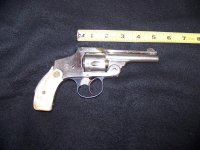Paladin, do you get paid by Dillon to write articles like that one or is it just a bragging rights sort of arrangement? Also, why did S&W abandon the top break, auto-eject design? Was the design not strong enough to allow for more powerful cartridges?

One of my first articles appeared in the
Blue Press before I worked for Dillon. It was a nostalgic piece on my first gun, purchased by my dad and me when I was just 11 years old. I sent a copy to Jeff Cooper, and he wrote back to give me encouragement, having enjoyed the piece. I was very proud that he'd take the time to do that. After I wrote it, I worked full time for Dillon for 7 years and was their top salesman for almost all of that time. I used to write the articles for free when I worked there. It was fun, and kept me off the streets in my spare time. Then the
Blue Press editor arranged for a more or less token payment every time one of my articles appeared. I was happy with that, getting paid for what I liked to do. In the meanwhile, I also did articles for Guns & Ammo Handguns, American Gunsmith, and Gun Digest (2003 best article John Amber award winner, given in 2004). When I retired, Dillon paid me what they pay other gun writers, which was quite a bit more, and honored me by making me a contributing editor. I still enjoy writing the articles, and the money I earn from them enables me to buy more guns to write about. Such a deal, huh?
S&W topbreak revolvers were handy for ejection and loading, but the frame design was inherently weak compared to the side-ejecting design. Although the "hand ejectors" were a bit slower to eject, the difference in speed was small.
The Webley and Enfield revolvers stuck with the topbreak design quite a while beyond WWII. They did not use very powerful cartridges, though. I wrote an article about them in the April, 2011
Blue Press, which you can find here on page 40 of that issue. The last gasp of the "topbreaks."
http://www.bridleandbit.net/ebooks/bluepress/bluepressapr11/apr11/object_files/main.swf
John

